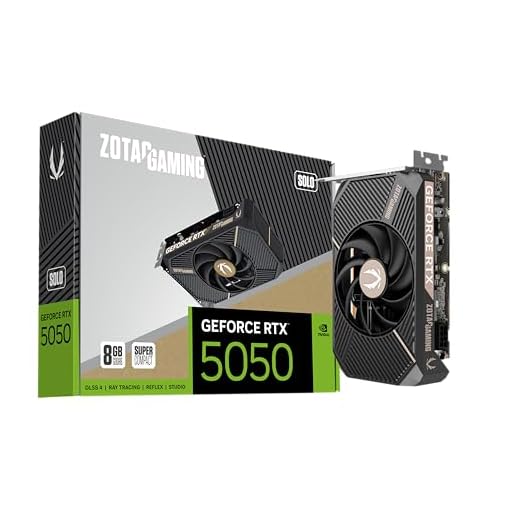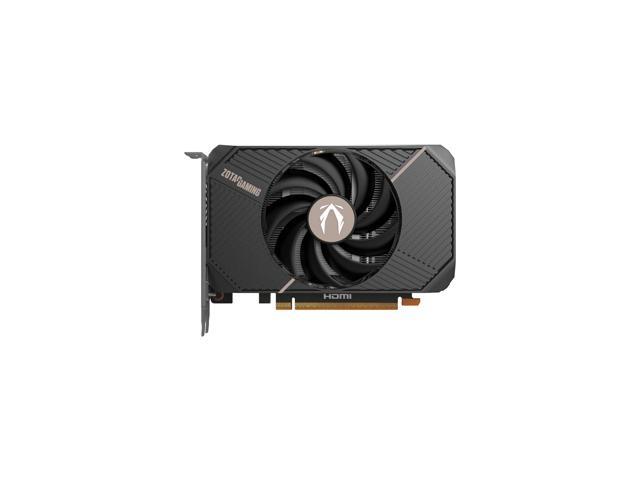
Introduction
Is the NVIDIA GeForce RTX 5050 a game-changer at $249 MSRP? Let’s find out. The NVIDIA GeForce RTX 5050 was launched late July of 2025, as the entry-level GPU for the GeForce RTX 50 Series family of graphics cards. Like all cards in the lineup for the RTX 50 Series, the GeForce RTX 5050 is based on the Blackwell architecture.
As we can see from the press slide, the starting MSRP for the GeForce RTX 5050 is aimed at a $249 MSRP price point, and is the successor to the GeForce RTX 3050, which was launched in January of 2022 at an MSRP of $249 as well. There was not a GeForce RTX 40 Series “xx50” class card in the previous generation, and nothing at the $249 price point in the last generation for desktop DIY. That makes the GeForce RTX 5050 leapfrog over the GeForce RTX 40 Series and now competes with an almost four-year-old graphics card, at the same price point and two generations ahead of the GeForce RTX 30 Series.
In today’s GeForce RTX 5050 GPU family review, we are going to take a deep dive into the performance evaluation of the GeForce RTX 5050’s experience in 11 games. We will show both average FPS as well as 1% Lows, including Native Resolution, DLSS Upscaling, and Ray Tracing at different game graphics settings ranging from Ultra to High, to Medium to Low. It’s a lot of graphs in this one, folks. This will give us a wide view of the GeForce RTX 5050 GPU’s performance, compared to the previous $249 GPU from NVIDIA, the GeForce RTX 3050. We will also include a GeForce RTX 4060 and Radeon RX 7600 for reasons you’ll soon see. Before we get into that, let’s dive into the specs.
GeForce RTX 5050 Specifications
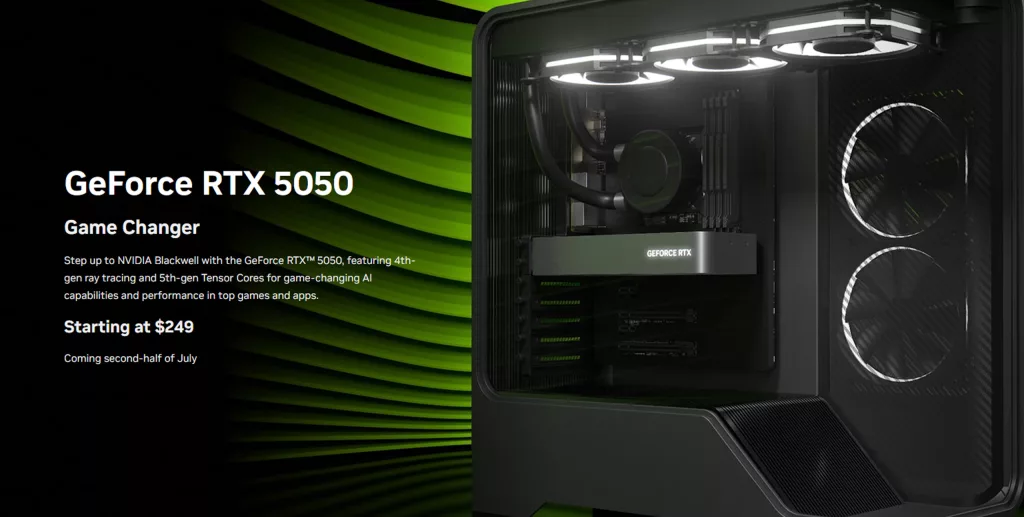
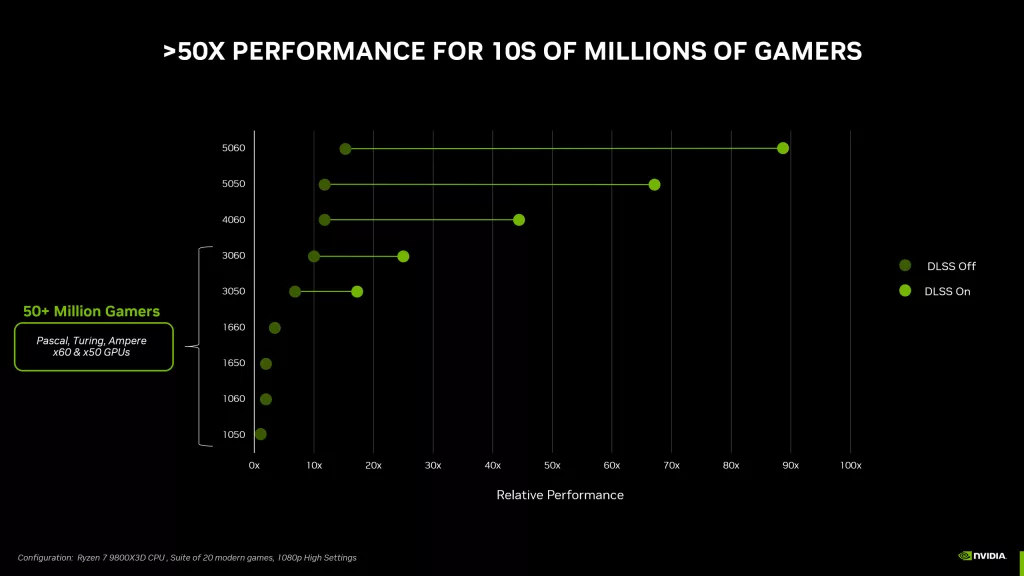
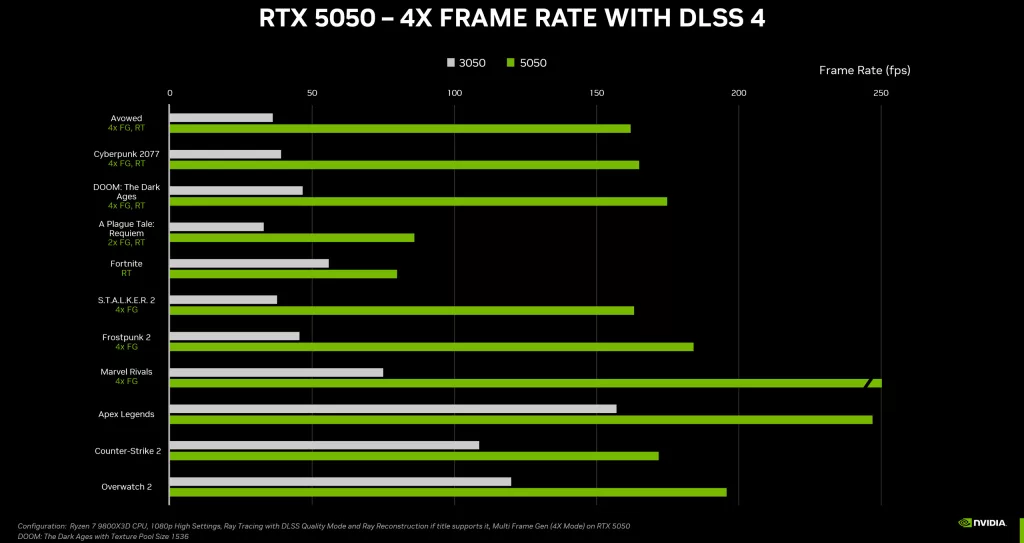
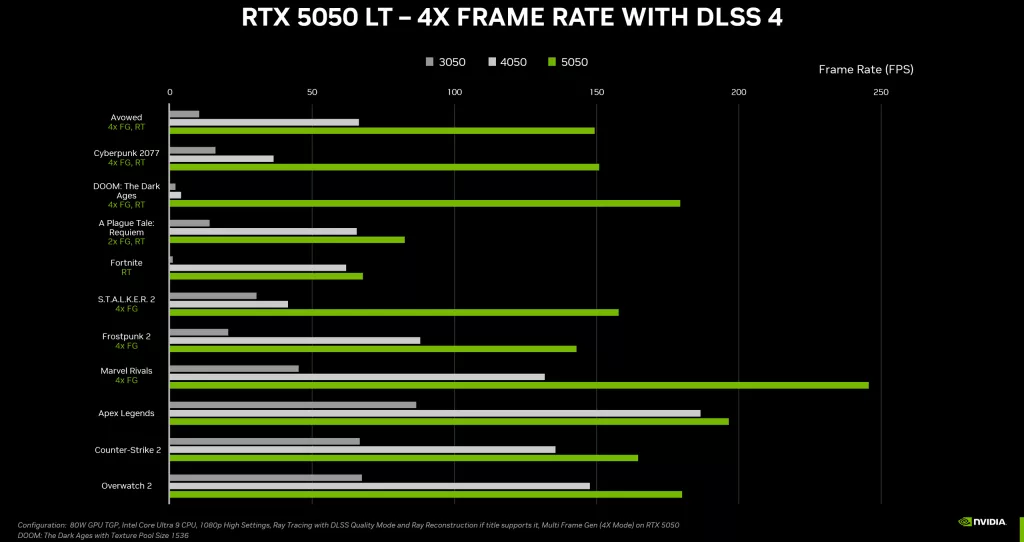
| GeForce RTX 3050 | GeForce RTX 5050 | GeForce RTX 4060 | GeForce RTX 5060 | |
|---|---|---|---|---|
| GPU Codename | GA106 | GB207 | AD107 | GB206 |
| Architecture | Ampere | Blackwell | Ada Lovelace | Blackwell |
| SMs | 20 | 20 | 24 | 30 |
| CUDA Cores | 2560 | 2560 | 3072 | 3840 |
| RT Cores | 20 | 20 | 24 | 30 |
| Tensor Cores | 80 | 80 | 96 | 120 |
| ROPs | 32 | 32 | 48 | 48 |
| Texture Units | 80 | 80 | 96 | 120 |
| GPU Boost | 1777MHz | 2572MHz | 2460MHz | 2497MHz |
| VRM | 8GB GDDR6 | 8GB GDDR6 | 8GB GDDR6 | 8GB GDDR7 |
| Memory Interface | 128-bit | 128-bit | 128-bit | 128-bit |
| Memory Clock | 14Gbps | 20Gbps | 17Gbps | 28Gbps |
| Memory Bandwidth | 224GB/s | 320GB/s | 272GB/s | 448GB/s |
| TDP | 130W | 130W | 115W | 145W |
| MSRP | $249 | $249 | $299 | $299 |
In the GeForce RTX 50 Series family, the GeForce RTX 5050 starts the lineup at the bottom, with a $249 MSRP; it is the lowest-tier in the family for DIY desktop PCs. Comparing the GeForce RTX 5050 with the next-tier up, GeForce RTX 5060, we can see that both use the Blackwell architecture, but RTX 5050 uses the smaller GB207 die, while RTX 5060 uses the larger GB206 die. We can see that the GeForce RTX 5050 has 33% fewer SMs, RT Cores, Tensor Cores, and ROPs.
The GeForce RTX 5050 is clocked within 3% of the GeForce RTX 5060, with just a slightly higher boost clock. The GeForce RTX 5050 has 8GB of VRAM, just like the GeForce RTX 5060; however, it uses GDDR6 VRAM instead of the RTX 5060’s GDDR7. This means that the GeForce RTX 5050 runs a bit slower than the RTX 5060 at 20Gbps, on a 128-bit bus, giving it 320GB/s of memory bandwidth. The TDP is 10% lower on the GeForce RTX 5050.
Comparing the GeForce RTX 5050 to the previous generation, which had a $249 GPU (the GeForce RTX 30 Series), we can see that the architecture has changed, but so has the die-class. The GeForce RTX 3050 used a larger GA106, while the GeForce RTX 5050 is actually a tier-down using a smaller GB207 die. What is interesting between the two GPUs is the fact that the GeForce RTX 5050 matches the GeForce RTX 3050 in the number of SMs, CUDA Cores, RT Cores, Tensor Cores, and ROPs. Naturally, the iterations of the RT Cores and Tensor Cores are different, however.
The GeForce RTX 3050 uses 2nd Gen RT Cores and 3rd Gen Tensor Cores, while the GeForce RTX 5050 uses the latest 4th Gen RT Cores and 5th Gen Tensor Cores. Otherwise, there are two big bumps in clock speed: the GPU Boost and the memory. The GPU Boost on the GeForce RTX 5050 is 45% higher than the GeForce RTX 3050, which is quite a big difference, and the memory frequency increases by 43% from 14Gbps to 20Gbps. The memory bandwidth also increases by 43% up to 320GB/s on the RTX 5050. Through all of this, the TDP power stays the same at 130W.
Since there isn’t a GeForce RTX 40 Series equivalent of the GeForce RTX 5050, it is actually quite interesting to make some comparisons to the GeForce RTX 4060, a $299 GPU. The GeForce RTX 4060 is based on the previous architecture, Ada Lovelace. The GeForce RTX 4060 has a leg up on the GeForce RTX 5050 in raw SM’s, CUDA Cores, RT Cores, Tensor Cores, and ROPS with up to 20% more of each.
However, the new GeForce RTX 5050 actually has a leg up on the GeForce RTX 4060 in terms of memory speed and bandwidth. The GeForce RTX 5050 runs at 20Gbps and 320GB/s of memory bandwidth, compared to the GeForce RTX 4060 at 272GB/s, making the GeForce RTX 5050 have 18% more bandwidth. The TDP is also higher at 130W, and the GPU Boost clock is higher. This will make an interesting comparison in testing.
Goals and Testing Scenario
Our goals today are to look at the GeForce RTX 5050 GPU family performance, in comparison to the GeForce RTX 3050, as well as the GeForce RTX 4060, and then also an AMD Radeon RX 7600. The GeForce RTX 3050 comparison is obvious; we need to see what kind of performance uplift is provided with the new RTX 50 series at $249 compared to the previous card available at $249 as well, the GeForce RTX 3050.
The GeForce RTX 4060 comparison is a useful test to see how the RTX 50 series compares to a higher-tier RTX 40 series, and since there was no RTX 4050, the RTX 4060 is it for the comparison. The Radeon RX 7600 is also interesting, though it is not AMD’s latest generation. The AMD Radeon RX 7600 debuted and launched at $269, and right now, AMD does not have a $249 video card in the RDNA4 series. The Radeon RX 7600 is available for under $249 today, and is the lowest-tier in the last generation RDNA3, making a valid comparison for someone looking in this price range. All of these are 8GB video cards.
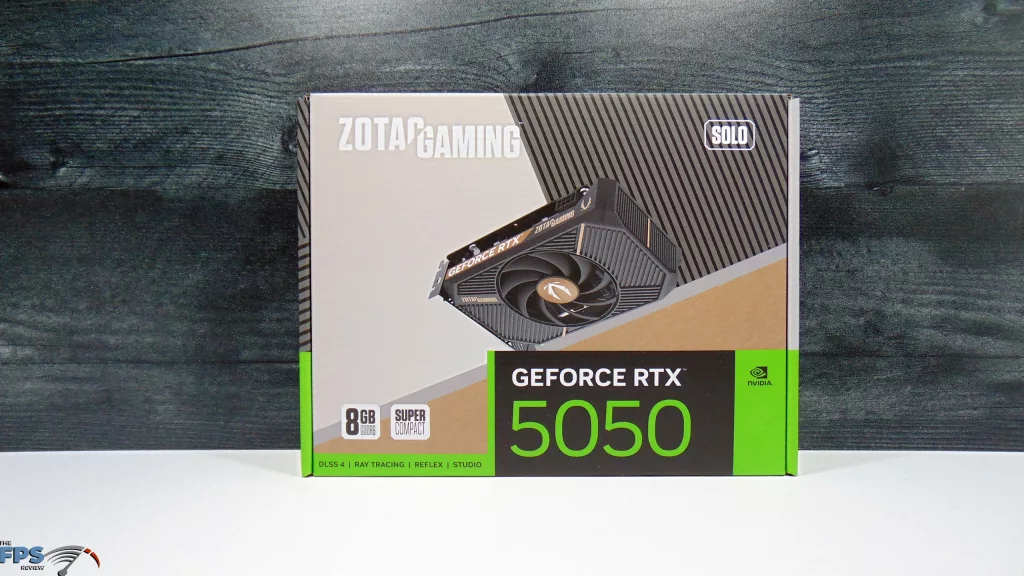
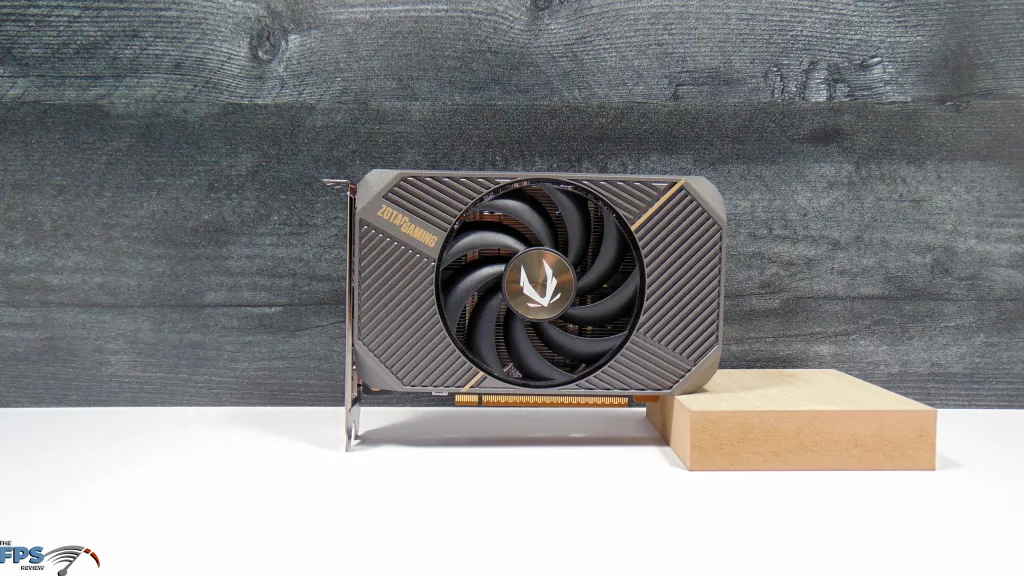
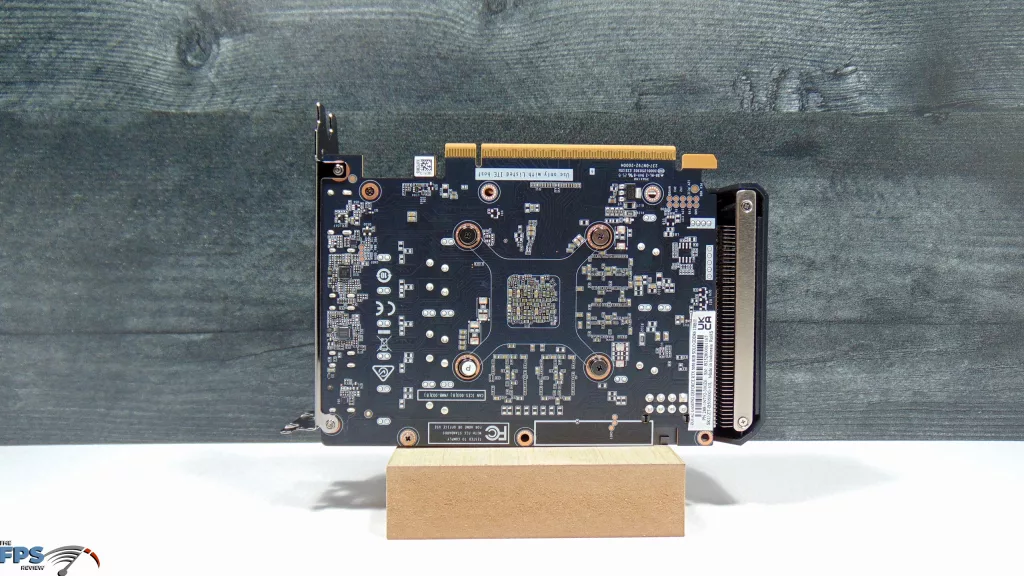
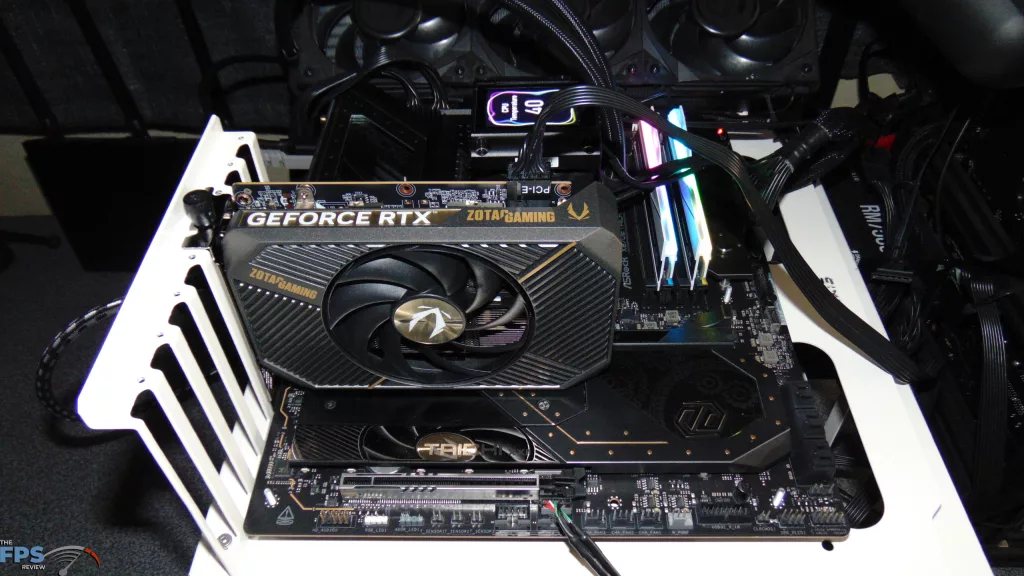
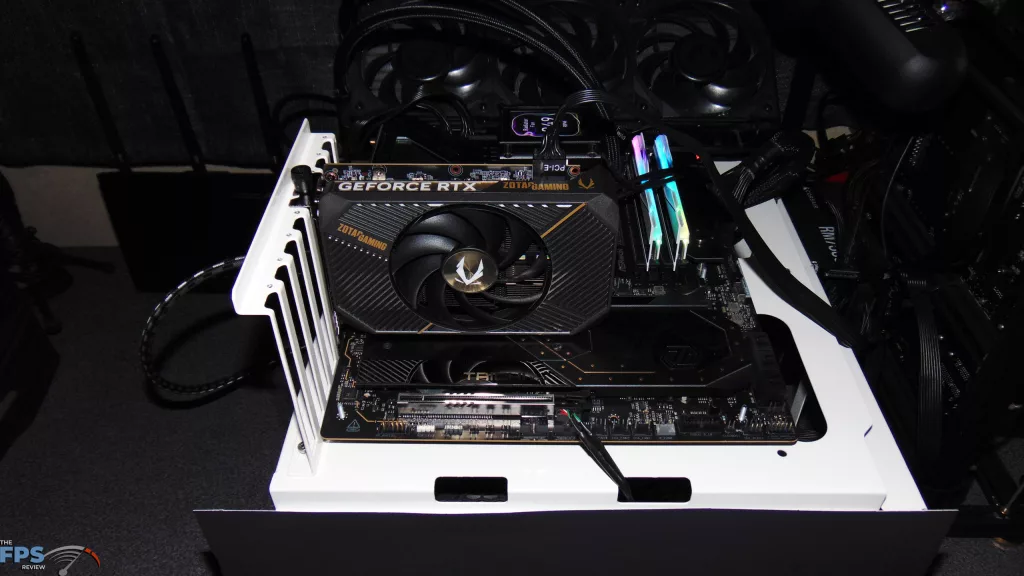
To make this review happen, we are using custom AIB video cards, except in the case of the AMD Radeon RX 7600, which is a made-by-AMD reference model. Our review today is themed around small form factor designs, i.e., small compact video cards in these classes. The video card representing the GeForce RTX 5050 is a ZOTAC GAMING GeForce RTX 5050 SOLO that we purchased ourselves. This video card runs at NVIDIA reference clock speeds.
The video card representing the GeForce RTX 4060 is a GIGABYTE GeForce RTX 4060 OC Low Profile 8G video card, which, as you can see, is a Low Profile card, and has a factory overclock of 2475MHz, only 15MHz above the reference NVIDIA clock speed of 2460MHz. The GeForce RTX 3050 is represented by the PNY GeForce RTX 3050 8G VERTO Dual Fan, a dual-fan compact video card that runs at the NVIDIA reference clock speed of 1777MHz.
In our game testing today, you’ll find that each page represents a game tested, and there are 11 total games. We are using mostly in-game, real-world manual run-throughs for testing, capturing data with NVIDIA Frameview. In 3 of the 11 games, we are using the in-game benchmark, but capturing the data with Frameview, so we can report 1% Lows. We have an average framerate, and 1% Lows reported for each run, and we have separated out Native Resolution and DLSS Upscaling into separate graphs.
We are also going to enable Ray Tracing where possible, and for those tests, DLSS/FSR Upscaling is enabled for the run-through. Many games we are using are UE5 games, which natively enable Ray Tracing by the game engine, and thus are Ray Traced enabled games at all times, we’ll note those in the review. We are also testing at multiple in-game graphics quality presets, from Low to Ultra at 1080p, so that we can see a range of performance on the GeForce RTX 5050, and if 8GB of VRAM is a hindrance. All data is captured fresh as of September 2025.


